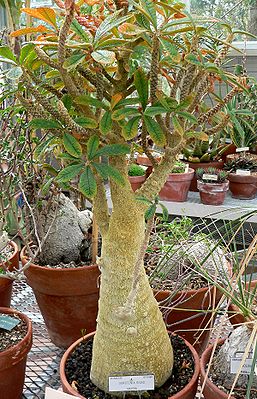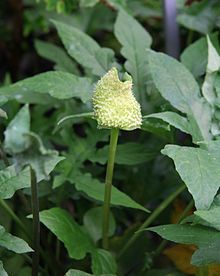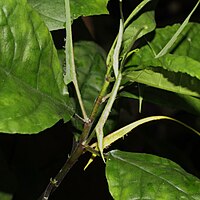Dorstenia
| Dorstenia | ||||||||||||
|---|---|---|---|---|---|---|---|---|---|---|---|---|

|
||||||||||||
| Systematics | ||||||||||||
|
||||||||||||
| Scientific name | ||||||||||||
| Dorstenia | ||||||||||||
| L. |
The dorstenia ( Dorstenia ) are a plant genus of the family of the Mulberry family (Moraceae). The 100 to 170 species occur in the New World and from Africa via Madagascar and the Arabian Peninsula to Sri Lanka and western India .
description

Appearance and leaves
Dorstenia species are diverse and very variable in many of their properties. The spectrum within the genus Dorstenia ranges from small, annual , perennial herbaceous plants with and without rhizomes or tubers , geophytes and woody shrubs to succulents (stem or leaf succulents). Their juice is usually milky white, less often yellow or colorless. The hairs present in most species are at least partially hook-shaped.
The leaves, which are usually spiral and rosette-like, rarely arranged in two rows, are varied. The leaf blades can be shield-, hand-, or foot-shaped, whole, incised, lobed or pinnate. Often the leaf margins are serrated or notched. The ever-present Stipules are similar to many forms; mostly they are leathery, sometimes large, leaf-like and durable or sometimes small, awl-shaped and sloping early.
Inflorescences and flowers
The inflorescences are pseudo-flowers (pseudanthia) formed from widened shoot axes , which in the mulberry family are called "blossom cake" (not closed here; coenanthium). Many tiny flowers are grouped together in them. The pseudo-flowers can be flat, convex, concave, round, oval, square, lobed, split in two, star-, boat- or tongue-shaped. Their color varies from green to yellowish and reddish to purple and brown. Under the inflorescence are usually bracts (bracts), scattered or who sometimes wear appendage in rows. Sometimes the bracts are missing and only their remaining tooth-shaped, awl, spatulate or ribbon-shaped appendages are recognizable.
The spherical, club-shaped, conical or warty flowers are unisexual , the female flowers within a dummy flower mature first. The male flowers are either scattered between the female flowers or concentrated on the outer edge or separated by a flower-free zone on the outer edge. They are stalked and carry one to four (usually two to three) free or almost free tepals and one to four (usually two to three) stamens . The seated female flowers bear röhrig intergrown Tepalen and a free ovary with one or two, then mostly uneven scars . The stone fruits are embedded in the widened inflorescence axis and, when ripe, are scattered by a turgescence spinning mechanism.
Systematics and distribution
The entire distribution area extends from South , Central and North America with the Caribbean across Africa including Madagascar and the Arabian Peninsula to western India and Sri Lanka .
Dorstenia is the second largest genus of the mulberry family with around 105 species according to some authors. Charles Plumier named it in honor of the Marburg botanist and professor of medicine Theodor Dorsten (1492–1552). Carl von Linné later took over this name. Because of the great variability of many species, which often develop different looking habitat forms, many taxa have been described in the past that are now considered synonyms . Up to 170 species can be found in other authors.
Types (selection)
- Dorstenia alberti Carauta, M.Valente & Sucre : It is an herbaceous plant from Brazil .
- Dorstenia annua Friis & Vollesen : It is an annual, succulent plant from Sudan and Kenya .
- Dorstenia appendiculata Miq.
- Dorstenia arifolia Lam. : It is an herbaceous plant from Brazil.
- Dorstenia asaroides Gardner
- Dorstenia astyanactis Aké Assi : It is a succulent and epiphytic plant with drooping stem axes from the Ivory Coast .
- Dorstenia bahiensis Klotzsch : It is an herbaceous plant from North and Central America .
- Dorstenia barnimiana Schweinf. : It is a succulent, geophytic plant with a spherical to pear-shaped tuber from Africa .
- Dorstenia benguellensis Welw. : It is a very variable, succulent and geophytic plant with a disc-shaped tuber from Africa.
- Dorstenia belizensis C.C. mountain
- Dorstenia benguellensis Welw.
- Dorstenia bergiana Hijman : It is a succulent plant with a spherical tuber from the Democratic Republic of the Congo .
- Dorstenia brasiliensis Lam. : It is a somewhat succulent plant from South America ( Uruguay to Venezuela )up to 20 cm high.
- Dorstenia brownii Rendle
- Dorstenia bryoniaefolia Mart.
- Dorstenia buchananii Engl .: It is a succulent plant with a disc-shaped, spherical or pear-shaped tuber from SE Africa.
- Dorstenia cayapia Vell.
- Dorstenia contrajerva L .: It is an herbaceous plant from North America.
- Dorstenia crispa Engl.
-
Dorstenia cuspidata A. Rich. : It is a succulent plant with a disc-shaped to spherical tuber from Africa and Madagascar :
- Dorstenia cuspidata Hochst. ex A.Rich. var. cuspidata
- Dorstenia cuspidata var. Brinkmaniana Hijman
- Dorstenia elata Gardner
- Dorstenia ellenbeckiana Engl .: It is a succulent, geophytic plant with a spherical to disc-shaped tuber from Ethiopia .
- Dorstenia erecta Vell.
- Dorstenia faria A. Paiva
- Dorstenia foetida (Forssk.) Schweinf. : It is a very variable, succulent shrub native to East Africa and Arabia .
- Dorstenia gigas Schweinf. ex Balf. f. : It is a succulent shrub up to 4 m high with a swollen base from the island of Socotra .
- Dorstenia goetzei Engl .: It is a succulent, rhizome-forming plant from Kenya and Tanzania .
- Dorstenia gypsophila Lavranos : It is a succulent shrub up to 1.2 m high with a swollen base from Somalia .
- Dorstenia hildebrandtii Engl .: It is a succulent plant with a thickened trunk from southern to eastern Africa.
- Dorstenia hispida Hook.
- Dorstenia indica Wall. ex Wight : It is a succulent plant native to southern India and Sri Lanka .
- Dorstenia mannii Hook. f. (Syn .: Dorstenia intermedia Engl. ): It is an herbaceous plant from West and Central Africa .
- Dorstenia martiana Miq.
- Dorstenia montevidensis Gardner
- Dorstenia multiformis Miq.
- Dorstenia nervosa Desv.
- Dorstenia opifera Mart.
- Dorstenia pernambucana Arruda
- Dorstenia plumeriaefolia fish.
- Dorstenia poinsettiifolia Engl .: It is an herbaceous plant from Cameroon .
- Dorstenia prorepens Engl .: It is an herbaceous plant from West and Central Africa.
- Dorstenia psilurus Welw. : It is a somewhat succulent, bulbous plant from Angola , Cameroon, Tanzania and Uganda .
- Dorstenia radiata Lam.
- Dorstenia rotundifolia Arruda
- Dorstenia setosa Moric.
- Dorstenia schliebenii Mildbr. : It is an herbaceous plant from Tanzania.
- Dorstenia socotrana A.G. Miller : It is a succulent, geophytic plant with a spherical to egg-shaped tuber from the island of Socotra.
- Dorstenia tayloriana Rendle : It is an herbaceous plant from Kenya.
- Dorstenia tenuifolia Engl.
- Dorstenia tenuiradiata Mildbr. : It is a succulent plant from Tanzania up to 1 m tall.
- Dorstenia tomentosa fish.
- Dorstenia turnerifolia fish. & CAMey. (Syn .: Dorstenia argentata Hook. F. ): It is an herbaceous plant from Brazil.
- Dorstenia vivipara Welw. : It is a bulbous, succulent plant from Angola.
- Dorstenia vitifolia Gardner
- Dorstenia warneckei Engl .: It is a succulent plant from Kenya and Tanzania.
- Dorstenia yambuyaensis De Wild.
- Dorstenia zambesiaca Hijman : It is a tiny (15 mm high) plant from Mozambique .
- Dorstenia zanzibarica olive. : It is a succulent plant native to Kenya, Tanzania, and the island of Zanzibar .
literature
- Jean-Jacques de Granville: Notes on the biologie florale de quelques espèces du genre Dorstenia (Moracées) , Cahiers ORSTOM. Série Biologie, 1971, pp. 61-97.
- Frank K. Horwood: Some notes on the genus Dorstenia , In: Cact. Succ. J. (US) , 1974: 46 (5), pp. 223-229 and 46 (6), pp. 287-292.
- Cornelis Christiaan Berg & Maria EE Hijman: The genus Dorstenia (Moraceae) , In: Ilicifolia 2, 1999, p. 33.
- Thomas Brand: Succulent Dorstenia species - extravagant and easy to care for , KuaS 53 (7), 2002, pp. 183–188.
Individual evidence
- ^ Charles Plumier: Nova Plantarum Americanarum Genera . Leiden 1703, p. 29
- ^ Carl von Linné: Critica Botanica . Leiden 1737, p. 92
- ↑ Carl von Linné: Genera Plantarum . Leiden 1742, p. 50
- ↑ Profile of Dorstenia foetida . (English)
- ↑ Profile of Dorstenia gigas . ( Memento of the original from September 26, 2006 in the Internet Archive ) Info: The archive link was inserted automatically and has not yet been checked. Please check the original and archive link according to the instructions and then remove this notice. (English)
Web links
- The genre at GRIN.
- Richard P. Wunderlin: Moraceae: Description of the Genus in the Flora of North America , Volume 3. (English)
- Description of the genus in the Flora of Zimbabwe . (English)
- Inflorescence of a Dorstenia . (English)
- Profile of Dorstenia argentata . ( Memento from June 13, 2007 in the Internet Archive )
- Profile of Dorstenia barnemiana . ( Memento from June 24, 2004 in the Internet Archive )
- Profile of Dorstenia psilurus . ( Memento from June 9, 2007 in the Internet Archive )








